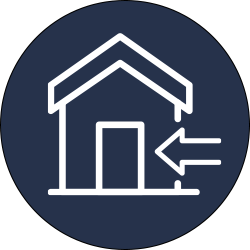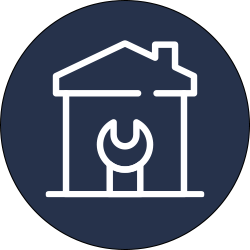Pigeon Control
Do you need to get rid of pigeons? We can help!

Pigeon Removal Strategies
Pigeons are abundant and look for roosting and nesting spots that resemble the rocks and cliff ledges they prefer. Having pigeons in your yard means you have gutters, chimney ledges, or balconies they enjoy for scoping out the area for food. Pigeons may also use eaves, barns, sheds, or roof vents to build a nest.
At Trutech, we value the lives of each and every animal that we come across. That is why our humane pigeon removal techniques are not only effective but are also ethical. No matter what your issue is, the experts at Trutech are here to help. Don’t wait until pigeons cause hundreds of dollars worth of damage to your property. Call Trutech for all of your pigeon removal and pigeon control needs.
Pigeon Problem

Signs a Pigeon is on Your Property
Pigeons are one of the most common birds that live among people. They are comfortable near residence and commercial properties. Whether living in a residential suburb or urban neighborhood, understand when they move from a general nuisance to a problem:
- Consistently hearing pigeon noises
- Buildup of droppings on your property
- Evidence of nests on your home or inside.

Dangers of Pigeon Infestation
Pigeons can cause problems when they find a roosting spot that is on your house or commercial property. Their presence damages your property and spreads diseases. The dangers of a pigeon infestation include:
- Diseases spread by pigeon droppings
- Structural damage from the acid in droppings
- Risk of fire from nests in vents
- Water damage risk from block gutters
Pigeon Control Solutions

Pest Inspection for Pigeons
Backyards are common pigeon hangouts, as they provide abundant meals. Lawns with bird feeders, sunflowers, or seed-bearing plants are especially attractive. Apple trees, commonly found in orchards and around homes nationwide, are some of their favorite food sources. Roof ledges, eaves, and attics also provide places for pigeons to roost and escape from predators or harsh weather.

Trapping & Removal
Depending on the location of the pigeon problem on your property, there are several strategies we employ to get rid of pigeons. For large flocks affecting commercial properties, pigeon trapping can be an option.
- Install barriers
- Clip and clear roosting branches
- Installing spikes
- Setting up wires

Prevention & Exclusion
Blocking access to roosting areas will force pigeons to find other areas to gather. Use wood, metal, or wire mesh to block access to eaves, vents, and lofts. If possible, altering the slope of problem roosting areas can drive pigeons away, as the pests dislike ledges at angles of 45 degrees or greater. If all else fails, installing porcupine wire or bird spikes on ledges is an unsightly yet effective way to deter them. However, some savvy birds may manage to maneuver around these spikes and continue to roost.
Frequently Asked Questions
Since they depend on humans for food and shelter, pigeons are often found roosting in residential areas. These noisy pests gather in yards and on roofs in large numbers, which can overwhelm homeowners.
Pigeon poop is a serious issue as well. It collects on sidewalks and the sides of buildings, creating slipping hazards and staining homes. The pests’ feces also spread several pigeon diseases.
Illnesses spread via these birds’ droppings include:
- Histoplasmosis – This airborne fungal sickness affects the respiratory system, sometimes with fatal results.
- Salmonellosis – Often called food poisoning, a Salmonella bacterial infection causes stomach pain, chills, fatigue, and fever.
- Psittacosis – Spread through the inhaled dust of dried pigeon poop, this disease leads to fever, chills, muscle pain, and difficulty breathing.
- Toxoplasmosis – Pregnant women and people with lower immune function are more affected by this parasite. Infected individuals suffer flu-like symptoms.
- Cryptococcosis – Another fungal ailment that results in lung infection, cryptococcosis can spread to the brain and is potentially fatal.
- Newcastle Disease – Though it can be transmitted to humans, this illness typically affects other birds like poultry. It causes sudden death.
In addition to these pigeon diseases, the pests host fleas, lice, mites, and ticks. The parasites also carry harmful illnesses, such as Lyme disease, that can be spread to humans.
Pigeons are common city and suburban pests, as they generally live close to humans. Assembling in large flocks, the birds can quickly annoy residents. Thankfully, there are several pigeon deterrents available to keep the pests away from houses and other buildings.
- Porcupine wire and bird spikes – These are fastened to windowsills, ledges, and other places where pigeons perch to prevent roosting.
- Frightening devices – Noise makers and predator decoys may scare the pests away.
- Bird netting – Hanging this special material over flat surfaces or around trees can keep birds from landing.
- Electric hot wires – This method delivers small shocks when the pests land.
- Chemical Repellents – Some products may be spread on ledges and trees to irritate birds’ feet or create a sticky texture they dislike.
Almost every pigeon deterrent comes with certain issues. Bird spikes and wire are difficult to keep clean because they collect feathers and feces. Additionally, noise and frightening devices are less effective over time. Electric and chemical deterrents can be costly and dangerous to use or install.
Dust control gear is critical when clearing away pigeon nests because of the waste inside. The pests’ droppings may spread histoplasmosis and cryptococcosis, which is especially dangerous for people with immune system disorders. For safe pigeon control, call the trained professionals at Trutech.
Flying pests are tough to keep away from homes, and pigeons are no exception. While some people use bird strips and netting to stop them from landing, others turn to trapping pigeons. This method is often successful because the pests tend to stay in the same area. Several types of live pigeon traps are common:
- Loft Traps –Homeowners can screen in birds using their existing roosts. Set up the trap in a favorite pigeon gathering spot, but keep the entrance open until the birds inside are comfortable. Then, carefully close the trap’s door.
- Funnel Traps – Typically built from welded wire, these devices have cone-shaped doorways. Birds enter freely to eat but cannot escape through the smaller end of the funnel.
- Bob-Type Traps – These large pigeon traps have a small access door to remove the trapped birds. The key feature is the free-swinging bars that allow birds to enter. When the bars fall back into place, the birds are kept inside.
All three of these traps are often baited to attract pigeons. Special formulas are available, though cracked corn will also work.


